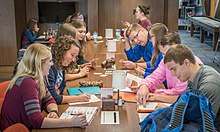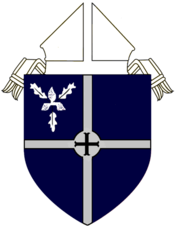University of Mary
 | |
| Motto |
Lumen Vitae (The Light of Life) |
|---|---|
| Type | Private |
| Established | 1959 |
| Affiliation |
Catholic Church (Order of Saint Benedict) |
| Endowment | $49.6 million[1] |
| President | Monsignor James Patrick Shea |
| Students | 3,314 (2017) |
| Undergraduates | 1,928 (2016)[2] |
| Location |
Bismarck, North Dakota, United States 46°43′N 100°45′W / 46.72°N 100.75°WCoordinates: 46°43′N 100°45′W / 46.72°N 100.75°W |
| Campus | Suburban / Rural |
| Affiliations | NCAA D-II |
| Mascot | Marauders |
| Website | www.umary.edu |
The University of Mary (abbreviated UMary or simply Mary) is a private, Christian, Catholic and Benedictine university near Bismarck, North Dakota, originally known as Mary College, established in 1959.
The university is the largest degree-granting institution in Bismarck. It has campuses in Rome and Peru, and also operates academic programs at satellite locations in North Dakota (Fargo, downtown Bismarck, Watford City, Grand Forks), Minnesota, Montana, Kansas, and Arizona. It is endorsed by The Newman Guide to Choosing a Catholic College. It was recognized as a College of Distinction (2017–2018), the only such institution in North Dakota.[3]
History
Since the University of Mary's beginnings as Mary College in the late 1950s, it has rapidly expanded. Founded in 1959 by the Benedictine Sisters of Annunciation Monastery as a women's college, it became fully co-educational in the 1960s. It achieved university status — becoming the University of Mary — in 1986.

The University of Mary is the only private Catholic university in North Dakota. It has been accredited by the Higher Learning Commission since 1969. Since its incorporation in 1959, the university's enrollment has grown from 69 to more than 3,000. Its undergraduate programs have grown from nursing and education to 65+ degrees, ranging from accounting to Catholic studies.
In 1986, the university began offering master's degrees in nursing, management, and education. It has added master's programs in business administration, counseling, occupational therapy, physical therapy, public administration, project management, clinical exercise physiology, Kinesiology, speech-language pathology, and bioethics. In 2001, the University of Mary unveiled its vision as "America's Leadership University." In this role, the university is committed to providing leadership experiences for every student. In 2005, the master's degree in physical therapy was replaced by a Doctor of Physical Therapy — the university's first doctorate. The first 26 candidates in this program received their PhDs in 2006.
The University of Mary has expanded options in order to make education accessible to working adults and to support lifelong learning in the region and beyond. The University of Mary Worldwide (formerly known as the Centers for Accelerated and Distance Education) offers accelerated undergraduate and graduate programs for the adult learner. Today, the University of Mary Worldwide has a total of 14 sites in the Upper Midwest and beyond, including the Butler Center in downtown Bismarck, Fargo Center in Fargo, North Dakota, and Billings Center in Billings, Montana. In 2005, the University of Mary launched several of its bachelor's and master's programs online. Today, students can earn graduate and undergraduate degrees online through UMary Worldwide.
In 2006, UMary initiated the Gary Tharaldson School of Business. Named for Gary Tharaldson, a North Dakota hospitality entrepreneur and industry innovator, the new school was designed to bridge the gap between the academic and business world. The 29,000-square-foot (2,700 m2) flagship facility that houses the Gary Tharaldson School opened in September 2008.
From the fall of 2009 to the Spring of 2010, the University of Mary searched for a facility as the base for its Rome, Italy program. It found one a ten-minute bus ride from the city center. The first students to study in this Rome program left the United States in the Fall of 2010.
The Catholic Studies Program, an initiative of UMary President Monsignor James P. Shea, was also launched in the fall of 2010. On October 19, 2010, the program was named in honor of Bishop Paul A. Zipfel, sixth bishop of the Diocese of Bismarck, North Dakota. The Catholic Studies Program is an interdisciplinary program designed to explore the Catholic Church's contributions to and influence on human thought and culture, past and present. The program invites students of any faith who wish to deepen their knowledge of Catholicism's rich history and living tradition.
Today, with a full-time faculty and staff of nearly 300, the University of Mary remains committed to continuing the mission of its founding Sisters: serving the people of the region in a spirit that fosters servant-leadership, preparing leaders in the service of truth.
Campus
.jpg)
The University of Mary is a rural campus located about four miles (6 km) south of Bismarck and sits on a hill overlooking the "Capital City." The campus includes 24 buildings. Several of the original buildings on campus were designed by architect Marcel Breuer.
The Harold Schafer Leadership Center is home to a leadership program that the university offers. The upper floor usually holds conferences and meetings while the lower floor is home to two computer labs.
The Benedictine Center for Servant Leadership is one of the oldest buildings on campus, since it previously served as the library and a priory for the Sisters. It primarily houses the university's administrative offices, including the Offices of the President, Academic Affairs, Undergraduate Admissions, UMary Worldwide, Public Affairs, Financial Aid, the Registrar, Student Accounts, Student Success Center, Student Development, Career and Testing Services, M-Card Office, and the Business Office. It is also home to the School of Education and Behavioral Sciences, three residence halls (below), and the Hauer Family Theater.

Boniface Hall is a women's residence hall. St. Joseph's Hall for Men is a men's faith-based residence hall. St. Scholastica's Hall for Women is a women's faith-based residence hall.
Welder Library was built in 1990 and is named for the university's president emerita, Sister Thomas Welder. This library houses a number of books and other media. The library building is also home to the humanities division of the School of Arts and Sciences.
Greg Butler Hall is a women's residence hall located just southeast of the Welder Library. Hillside Hall is a women's residence hall located just northeast of the Welder Library. An outdoor track and baseball field are located east of both halls.
The McDowell Activity Center (MAC) is the center of the athletics department and includes offices and lockers on the lower level and a weight room. The main use for this center is for the men's and women's basketball teams and the women's volleyball team. The McDowell Activity Center is located just north of Hillside Hall. The Tschider Center for Health Sciences occupies one wing of this building, and provides both office and classroom space for the human performance programs.

The Lumen Vitae University Center (LVUC) serves as a community gathering space for students and faculty. The campus restaurant, the Crow’s Nest, offers 24/7 dining. The Bookstore and Marauders Mart are located near the Crow’s Nest.
The Harold J. Miller Center is one of the oldest buildings on campus and houses science, math, occupational therapy, and a computer lab. This building is connected to the east side of University Hall. Arno Gustin Hall includes the main auditorium for the campus The Clairmont Center houses the music department as well as some classrooms, Campus Ministry, and Heskett Hall, which is a small performing stage and home to a few lecture classes. The Casey Center for Nursing Education houses the nursing and physical therapy departments. In addition, the information desk is located here as well as a lounge just east of the information area. Tennis courts are accessible just outside the north end of this part of the building.In addition, there are practice fields for football, softball, soccer, track & field, and baseball on campus.
Deichert and Boyle Halls are student apartments located at the far north end of campus. Just beyond Deichert Hall, on the northern most side of campus, lie "The Cloisters." The Cloisters is available to only upper and graduate level students. The Cloisters consists of three buildings, two suite-styled apartments and a student commons/campus pub. The two apartments are named after the Benedictine heritage sites Subiaco (women's) and Monte Cassino (men's). The student commons/campus pub is named "Chesterton's," in honor of the famous Christian essayist of the 20th century, G.K. Chesterton.
Athletics
The University of Mary is a member of the NCAA Division II and the Northern Sun Intercollegiate Conference. The University of Mary Marauders team colors are blue and orange. The Marauders field teams in 17 varsity sports, including football, basketball, swimming, soccer, indoor track and field, outdoor track and field, cross country, volleyball, baseball, softball, wrestling, and tennis.
